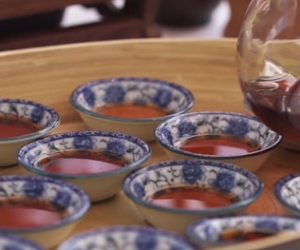


THEIR RESPECTIVE LONG HISTORIES HAVE CREATED KNOW-HOWS AND TRUE RITUALS AROUND THEIR PREPARATION, THEIR TASTING BUT ALSO THEIR CONSERVATION.
The Saint-Emilion – Pomerol – Fronsac wines and Pu’Er teas are exciting drinks. Their respective long histories have created know-hows and true rituals around their preparation, their tasting but also their conservation. Overlapping perspectives on Pu’Er teas and Saint-Emilion – Pomerol – Fronsac wines.
PU’ER TEAS AND SAINT-EMILION – POMEROL – FRONSAC WINES, THE INFUSION OF FLAVORS
The first step of enjoying a Pu’Er tea is to choose adequate water. Precision is needed! For tea, one generally needs acidic and low-mineral water*. Then, one needs to be careful with the measure of leaves, the brewing time and water temperature (90-95 °C), otherwise you’ll see the Pu’Er grand cru become bitter and astringent. In the cup, the tea quickly cools down to finally exhale all its aromas. For the Saint-Emilion – Pomerol – Fronsac wines, temperatures are also very important. At serving time, but not just. During winemaking, their control is very accurate. It is therefore necessary to maintain a temperature of 28-29 °C, to extract their color and tannins. So the similarities with the Pu’Er are striking: the grapes are macerated, a bit like tea leaves. Every day in the cellar we taste the juice, to reach perfection. It’s all about finding the right balance, whether for wine or tea.
SERVING THE PU’ER TEAS AND SAINT-EMILION – POMEROL – FRONSAC WINES
If the quality of a wine is judged by its ability to age, that of Pu’Er is seen by the number of infusions that can be done with the same leaves. On a great Pu’Er, you can dip the leaves in water 30 to 40 times, with still stable aromas. In China, the traditional method is to prepare Pu’Er is the Gong Fu Cha. In a small container, they make short successive infusions and drink the concentrated tea. In some regions of China, the Pu’Er is first served in a smelling cup, then in a tasting cup. The persistence of the tea’s flavors in the hollow of the empty cup is a way to extend with the nose the pleasure of the taste buds. To taste the Saint-Emilion – Pomerol – Fronsac wines, the container is also very important. Try it: depending on the depth of the glass and the neck opening, you will not feel the same flavors. The most used wine glass, tulip-shaped, is designed to develop the flavors in the glass and then focus on the nose of the taster.
THE STEPS OF TASTING
Once the tea and wine are served, they are tasted in the same way. The first step is to look at the color of the tea liquor, as you would observe a wine’s robe. Like the Saint-Emilion – Pomerol – Fronsac wines, which with age have their robe turn from ruby red to purple, the Pu’Er change color throughout their aging process. With a new Pu’Er, one year of age, the robe will have a golden, amber color. Over the years, a Pu’Er takes up more color, presenting copper highlights.
After the sight, comes the smell. Like the Saint-Emilion – Pomerol – Fronsac wines, the Pu’Er teas gradually reveal their primary aromas(related to the plant), secondary aromas (from fermentation) and tertiary aromas (born out of aging). Tea is usually served in a cup, so try to drink it in a wine glass. This surprising experience will allow you to appreciate the color of the tea and to fully grasp many flavors by direct olfaction.
* Water for the Pu’Er tea should have a dry residue of less than 180 mg / L. This information is found on the labels of mineral water bottles.